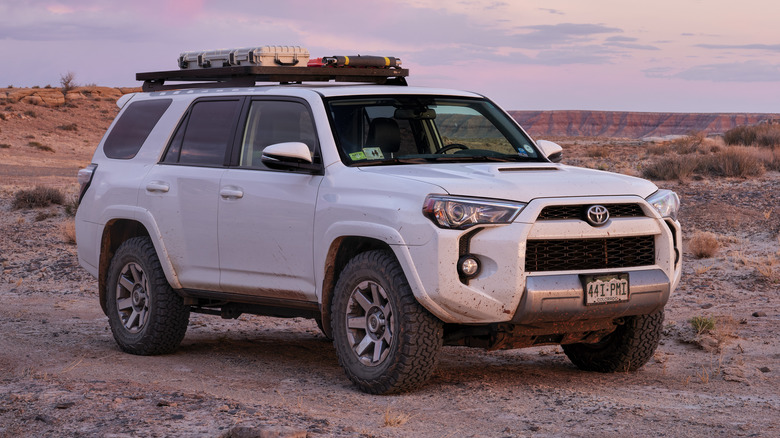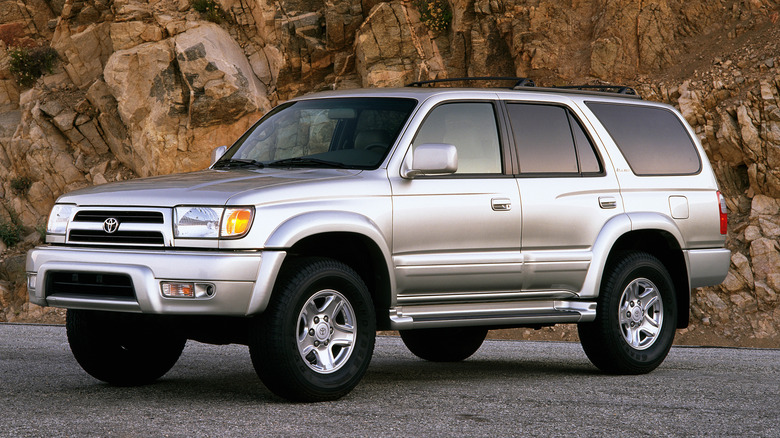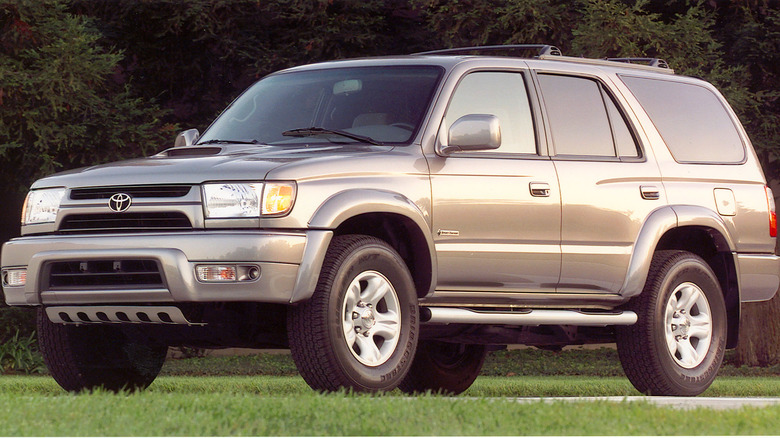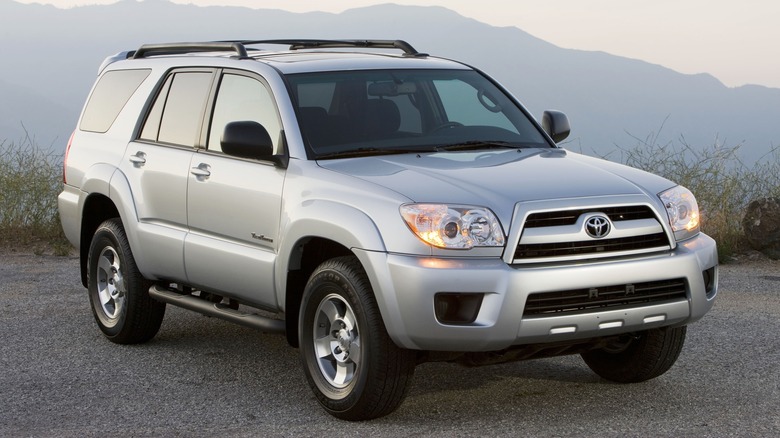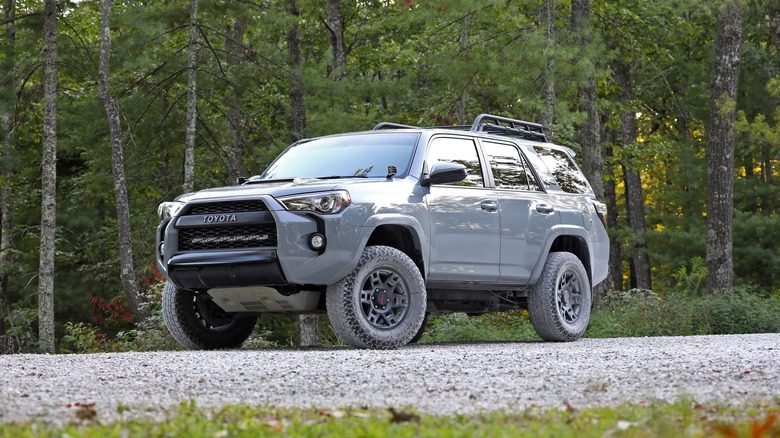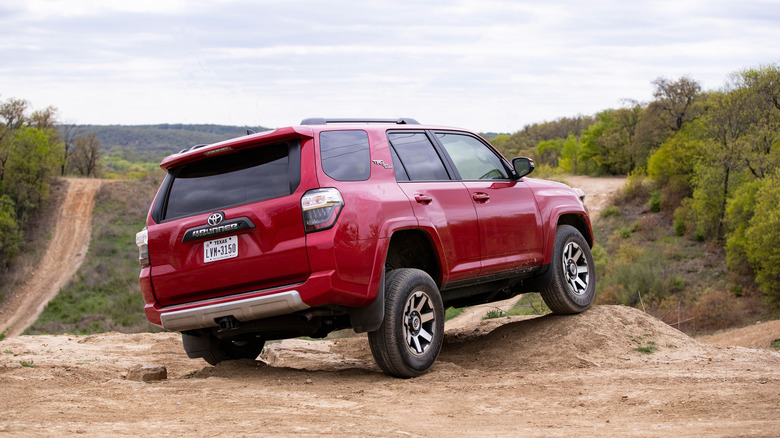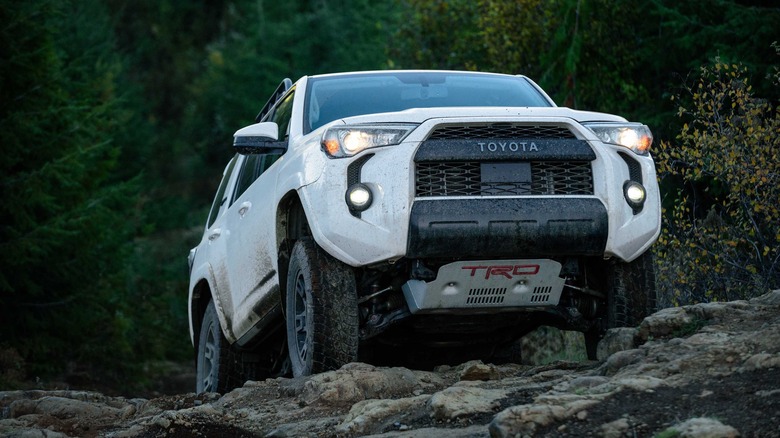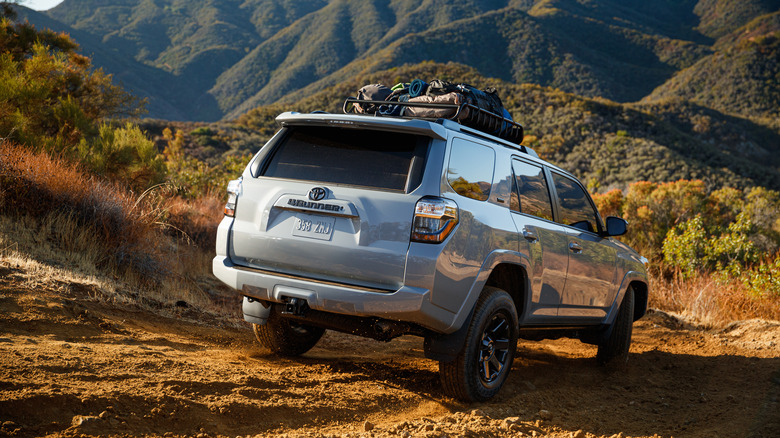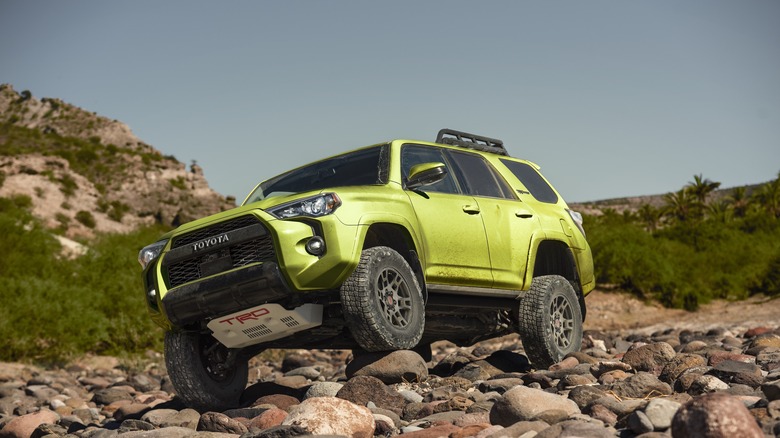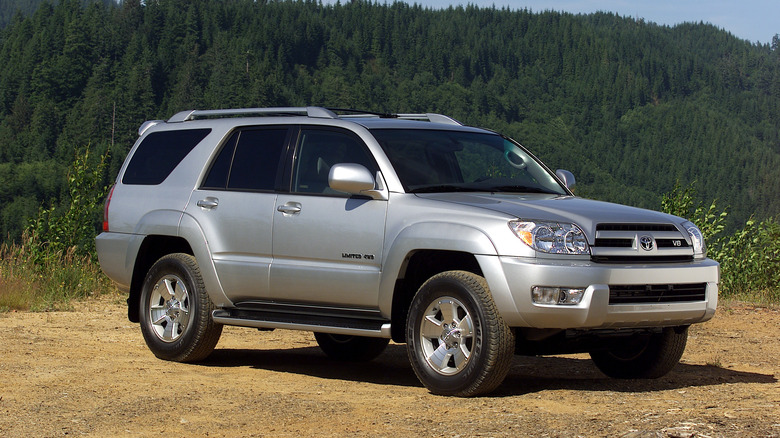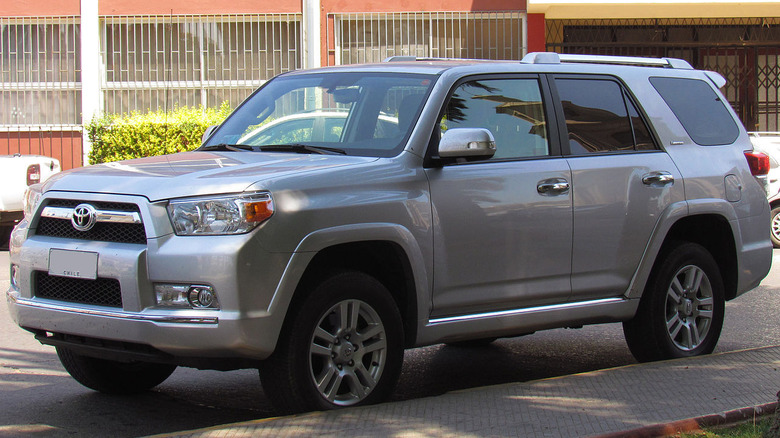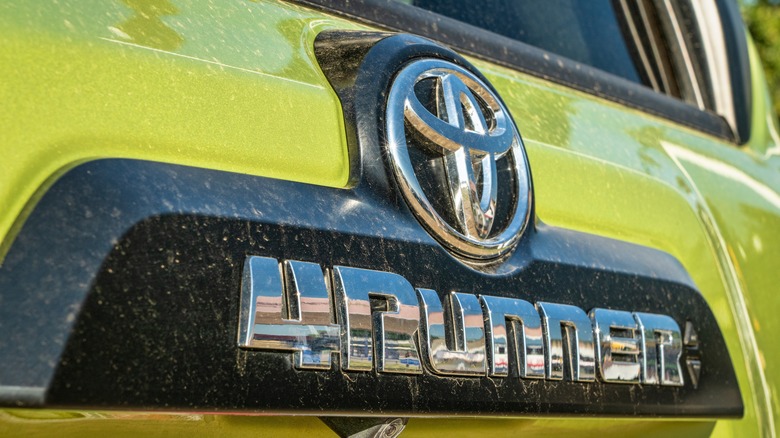8 Of The Best Toyota 4Runner Years Ever Made (And Some To Avoid)
The Toyota 4Runner has been an international SUV favorite since 1984. Originally a smaller SUV based on the sturdy Toyota Hilux pickup, it's been through through five different model generations and now sits in the mid-sized SUV class. However, no matter the size, 4Runners are known for their reliability.
4Runners are consistently ranked among the longest-lasting SUVs out there, with many owners clocking over 250,000 miles in their 4Runners. With good ground clearance as well as short front and back ends, a 4Runner can handle rocks or steep hills without issue. Plus, skid plates on the bottom are like armor for any terrain. Recent models also have advanced suspension to soak up rough trails, keeping rides comfortable no matter the conditions.
Of course, not every 4Runner year is created equally when it comes to dependability. Some model years have really kept owners loyal to the brand, while others might make them consider switching it up. To get an idea of which years killed it and which might not have been so great, we dug deeper into reviews and what owners actually said about their experiences with their 4Runners. Here are the very best model years of the Toyota 4Runner to look for — as well as a of the not so stellar ones.
1999 Toyota 4Runner
The 1999 4Runner was part of the excellent third iteration of the model and came in six different trims. This SUV had a really sturdy frame like the Land Cruiser and an independent coil spring suspension that gave it great balance off-road while still cruising smoothly on the highway.
When it came to power, buyers had two engine options. The base-level option was a 2.7-liter inline-4, producing around 150 horsepower and 177 pound-feet of torque, while those hoping for a bit more power could opt for the 3.4-liter V6. It unleashed 183 horses and a solid 217 lb-ft of torque. The V6 models also came equipped with Toyota's advanced full-time four-wheel drive system featuring a center differential for excellent traction in various road conditions.
The '99 Toyota 4Runner received a makeover giving it an even more attractive and eye-catching look. The outside styling was sharpened up with a new front bumper, slick multi-reflector headlights, and a sports package on some models, adding flares and a hood scoop. Inside, Toyota upgraded the cupholders and center console to handle drinks better. The fanciest trim model — Limited — even had automatic climate control for luxury.
Owners really loved their '99 4Runners. On Kelley Blue Book, it earned an amazing 4.8 out of 5 from customers, with 86% giving it a perfect five stars. The 1999 4Runner totally delivered what SUV buyers wanted, and it sold well thanks to its winning combo of power, reliability, and nice features.
2002 Toyota 4Runner
The 2002 Toyota 4Runner is known for its spacious cabin and comfortable ride. Passengers really appreciate the generous legroom and headroom. It feels quite airy inside, even for bigger groups.
Safety is clearly a top priority with this vehicle. It performed acceptably well in crash tests, while features like stability control, traction control, and brake assist give you that extra peace of mind both on and off-road. Being high off the ground also helps avoid any unwanted contact with obstacles. The iconic power-down hatch glass is handy for loading up gear, although getting in and out is easier said than done. The old-school dash was ready for a refresh, but the ride quality is about what you expect from a body-on-frame SUV — comfortable enough on pavement but definitely aimed at more rugged terrain, too.
People have logged crazy high mileages without major breakdowns on the '02 4Runner. As long as you stay on top of routine maintenance like oil changes, brakes, and fluid checks, these trucks will loyally soldier on whether you're highway cruising or off-road exploring. The Kelley Blue Book user ratings of 4.8 stars also indicate high customer satisfaction with the 2002 Toyota 4Runner.
2009 Toyota 4Runner
The 2009 Toyota 4Runner was a tough beast. As a member of the fourth generation of Toyota 4Runner, it won over hardcore off-roaders and city folks alike with its comfortable highway ride and exceptional off-road capabilities.
The '09 4Runner came with two 4WD drivetrains, multi-mode 4WD and full-time 4WD. You also have a choice between a gutsy 4.0L V6 (236 hp) or an even burlier 4.7L V8 (260 hp). Both are paired nicely with a slick five-speed automatic transmission. Toyota also offered the '09 4Runner SR5 4WD in a Trail Edition trim that included some nice off-road goodies like a locking rear differential, Bilstein mono-tube shocks for improved handling, and A-TRAC for better traction in tricky conditions. The seats are water resistant, and the audio system was upgraded with a detachable TomTom navigation unit.
This 4Runner comfortably seats four adults with room for gear, although it can technically squeeze in seven if you really need to. However, the third row is a little snug, and the seats don't fold flat, resulting in a hit to cargo space. The 2009 4Runner got pretty decent scores on J.D. Power, where it ranked third in the midsize SUV category that year, with 84 out of 100 rating, In addition, the Kelly Blue Book reviews were mostly positive with 87% of owners giving it a perfect 5-star rating.
2017 Toyota 4Runner
The 2017 4Runner came in six trims, with the Trail and Trail Premium trims renamed to TRD Off-Road and TRD Off-Road Premium. Under the hood is a 4.0-liter V6 and five-speed automatic transmission. Now, that powertrain would be great for a lighter vehicle, but some wondered why Toyota put it in the hefty 4Runner that weighs over 4,600 pounds. Still, the engine gets the job done and moves this beastly SUV with reasonable power.
The 2017 4Runner also does well when it comes to hauling stuff. Its cargo area has an optional sliding rear deck that extends out past the open tailgate, making it much easier to load up and unload your gear. However, the materials and styling aren't quite as modern or luxurious as some other SUVs from that time. In addition, riding in this 4Runner can be a bit bouncy and uneven, especially over bumpy paved roads. Gas mileage also isn't its strong suit.
That said, it scored an impressive 85 out of 100 for quality and reliability from J.D. Power. It also held its value pretty well, according to its Resale score of 84 out of 100. Finally, customers on Kelley Blue Book give it an average rating of 4.6 out of 5 stars.
2019 Toyota 4Runner
As part of Toyota's TRD Pro line – which also includes the Tundra and Tacoma trucks – the 2019 4Runner easily handles rugged terrain with its upgraded Fox shocks and 1-inch front lift. The suspension provides a plush highway ride while stiffening appropriately for gnarly trails. Thanks to the optional third row, which provides extra kid or gear-hauling potential, seating for up to seven is available. The standard two-row configuration comfortably seats five. The interior features nice finishes and materials throughout, especially in the Limited trim, and the V6 engine and sturdy hardware can tow up to 5,000 pounds.
While the Premium JBL audio system in the 4Runner provides clear sound, it could benefit from more volume and power. Also, the standard 6.1-inch touchscreen gets the job done for basic functions, though it is on the smaller side by today's standards. As with any vehicle, it has a few quirks. The ride gets bouncy over rougher surfaces compared to cushier crossovers and newer safety tech like adaptive cruise is also missing.
Still, as per usual the 2019 4Runner combines truck performance with car comfort. It received an overall rating of 82 out of 100, scoring particularly well with an 83 in quality and reliability and an 88 in resale on J.D. Power.
2020 Toyota 4Runner
As with previous versions, the 2020 Toyota 4Runner proved itself a rugged and capable SUV for outdoor adventures. Featuring TRD goodies, strong body-on-frame construction, generous ground clearance, and multi-mode 4WD, it confidently handled dirt trails and rugged terrain while remaining reasonably smooth on pavement, too.
Standard driver assists included Toyota's Safety Sense suite – a welcome safety net with features like forward collision warning, adaptive cruise, lane keeping, and automatic high beams. This helped the 4Runner earn a good 4 out of 5 star rating from the NHTSA. Inside, the straightforward cabin proved practical with comfy leather seats and big knobs for audio as well as climate controls. Cargo capacity was also impressive, especially with the convenient rear slide deck.
This SUV's infotainment is modernized with Apple CarPlay, Android Auto, and an enlarged touchscreen. Performance won't set records, but the 4.0L V6 provides adequate acceleration and 5,000-pound towing ability. According to owner ratings on Kelley Blue Book overall reliability has been very good, with just minor issues typical of an aging design. Edmunds found the 4Runner's ride a bit stiff and complained about road noise, but those trade-offs won't deter serious off-roaders or people who love the classic SUV styling.
2021 Toyota 4Runner
Only 4,000 of the limited-edition Trail model of the 2021 4Runner were produced, giving it a distinctive flair. Key features included a sturdy Yakima cargo basket to haul gear for camping trips and a removable cooler that slid perfectly into the back, while subtle black badging on the exterior gave it a stealthy look and aggressive tread provided confidence on rough roads less traveled. Toyota also included resilient all-weather floor liners to make cleanup a breeze after muddy hikes.
The 2021 4Runner TRD Off-Road model features locked rear differential and selectable drive modes that allow the SUV to adjust its powertrain for different driving conditions. All models also have sharp LED headlights, which is standard, while the TRD Pro trim sported suspension tweaks like Fox's retuned shocks. Styling also gets beefed up, like the mean-looking black TRD wheels and aggressive Nitto Terra Grappler tires that give drivers extra grip when exploring less-defined paths.
With a J.D. Power quality and reliability score of 81, the 2021 4Runner has proved relatively trouble-free over the long haul. Resale holds strong, too, at 89, which is a testament to Toyota's reputation and the 4Runner's enduring desirability. Likewise, Kelley Blue Book users gave it an average rating of 4.6 stars, commending its go-anywhere prowess both on and off the pavement.
2022 Toyota 4Runner
The 2022 4Runner really shines on the trails, where its solid ladder frame feels planted on rough terrain. While the 4.0L V6 could be more spirited, it has enough torque to get you where you need to go off-road. The specialized TRD Off-Road and TRD Pro trim levels up the ante further with extras like the Toyota Kinetic Dynamic Suspension System (KDSS).
The new-for-2022 TRD Sport joined the 4Runner lineup with enhanced on-road handling courtesy of its Cross-Linked Relative Absorber System suspension. It smooths out bumps impressively well for a vehicle of this size. You also get the choice of 2WD or part-time 4WD with low range, so it's adaptable to different conditions. Comfort wasn't an afterthought in the 4Runner's design, either. The cabin feels spacious, and the cargo room is generous, too. Standard driver aids like adaptive cruise control and lane-keep assist make long hauls less tiring. When you factor in its high resale value and 5,000-pound towing capacity, the 2022 Toyota 4Runner is a strong buy.
That said, given the truck-based architecture, fuel economy suffers, as you might expect. The interior materials and finishes also come across as somewhat utilitarian compared to more luxurious three-row SUVs in its price range.
2003 - 2005 Toyota 4Runner (Avoid)
Between 2003 and 2005, many Toyota 4Runner owners faced some really frustrating vehicle problems. The biggest annoyance with those years seemed to be all the excessive rust and corrosion forming underneath that could weaken the frame over time.
Owners of these 4Runners also complained that their suspension was prone to rusting out much earlier than it should have due to inadequate rustproofing during production. This led some owners to feel Toyota was aware of the problem from the start but didn't properly warn customers. Eventually, a class action lawsuit was filed alleging the automaker knew about the premature rusting yet failed to take meaningful steps to fix it or help cover repair costs for those affected.
The 2003 to 2005 models were also notorious for dashboard cracks. Brake issues popped up, too. The 2005 engines gave owners the most grief by far. Crippled air pumps and blown head gaskets can occur. The 2005 Toyota 4Runner initially got poor ratings in rear impact crash tests from the Insurance Institute for Highway Safety (IIHS), especially in the head restraints and seats category, where it scored a Poor. However, to be fair, it was later recognized in Car Complaints as having one of the lower driver death rates, showing that the overall safety record wasn't too shabby in the end.
2013 Toyota 4Runner (Avoid)
The 2013 Toyota 4Runner has had its fair share of problems. According to the NHTSA, Toyota has issued six recalls for issues like the frontal air bag inflator exploding and accessory hood scoop detaching. Owner complaints online reveal that the braking system seems to be a common source of trouble, and that excessive oil consumption leads to higher maintenance costs over time.
Cosmetic flaws seem to bother people, too, even if they are not critical. Faded or peeling paint isn't a good look and hampers resale value down the road. In response to widespread paint peeling complaints, Toyota acknowledged this as a manufacturing defect and extended the paint warranty to a generous 14 years. Other electrical glitches mentioned by some owners are problems with the door locks and the horn failing.
Still, the 2013 4Runner gets props in some areas, too. It accelerates pretty quickly for what it is, and the automatic transmission also shifts smoothly most of the time — if maybe a tiny bit on the early side — to help squeeze out better gas mileage.
[Featured image by order_242 from Chile via Wikimedia Commons | Cropped and scaled | CC BY-SA 2.0]
Our selection methodology
The Toyota 4Runner has stood the test of time as a well-built and capable SUV. After all these years, some model years still seem to have that extra bit of magic. To get a sense of which years might be the best of the best and which might be the not-so-great years, SlashGear took a close look at reviews and owner feedback.
Sites like Edmunds, J.D. Power, and Kelley Blue Book provided a good overview, but actual owner comments on forums and complaint databases painted a fuller picture. Reliability issues, design flaws, and customer satisfaction levels all helped point towards the higher and lower-rated years.
Of course, how happy owners feel about their ride counts for a lot in SlashGear's book. Model years with more five-star reviews seem to have delivered that new car feeling even years later. Things like 4WD systems, features, and driving dynamics also made some years stand out as a cut above. While no vehicle is perfect, these top picks seemed to give owners the robust go-anywhere ability and hassle-free driving they were looking for in a 4Runner.
